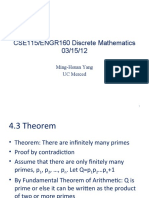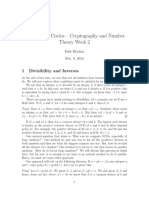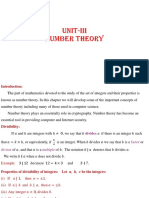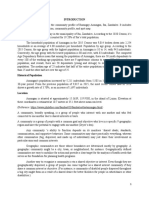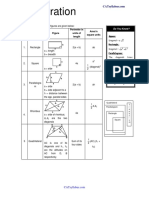Number Theory
Uploaded by
siamshaikh11Number Theory
Uploaded by
siamshaikh11Design & Analysis of Algorithm
Introduction to Algorithms by Cormen
Number Theoretic Algorithms
Chapter 31
Divisors
Let a, b and c be integers such that
a = b ·c .
Then b and c are said to divide (or are
factors) of a, while a is said to be a
multiple of b (as well as of c). The
pipe symbol “|” denotes “divides” so
the situation is summarized by:
b|a ∧ c|a.
Divisors Examples
Q: Which of the following is true?
1. 77 | 7
2. 7 | 77
3. 24 | 24
4. 0 | 24
5. 24 | 0
Division & Remainders
3
1.
1
Common Divisors
Greatest Common Divisor
Relatively Prime
● Let a,b be integers, not both zero. The
greatest common divisor of a and b (or
gcd(a,b) ) is the biggest number d which
divides both a and b.
● a and b are said to be relatively prime if
gcd(a,b) = 1, so no prime common divisors.
Greatest Common Divisor
Relatively Prime
Q: Find the following gcd’s:
1. gcd(11,77)
2. gcd(33,77)
3. gcd(24,36)
4. gcd(24,25)
Greatest Common Divisor
Relatively Prime
A:
1.gcd(11,77) = 11
2.gcd(33,77) = 11
3.gcd(24,36) = 12
4.gcd(24,25) = 1. Therefore 24 and 25
are relatively prime.
NOTE: A prime number are relatively
prime to all other numbers which it
doesn’t divide.
Greatest Common Divisor
Relatively Prime
EG: More realistic. Find gcd(98,420).
Find prime decomposition of each
number and find all the common
factors:
98 = 2·49 = 2·7·7
420 = 2·210 = 2·2·105 = 2·2·3·35
= 2·2·3·5·7
Underline common factors: 2·7·7,
2·2·3·5·7
Therefore, gcd(98,420) = 14
Greatest Common Divisor
The GCD and Linear Combinations
⚫Theorem 31.2:
If a and b are integers not both 0, then
gcd(a, b) is the smallest positive element
of the set {ax + by : x, y are integers} of
linear combinations of a and b.
Proof: see text p. 853.
The GCD and Linear Combinations (2)
⚫Corollaries:
◦ For any integers a and b, if d|a and d|b then
d|gcd(a, b).
◦ For all integers a and b and any nonnegative
integer n, gcd(an, bn) = n gcd(a, b).
◦ For all positive integers n, a, and b, if n|ab and
gcd(a, n) = 1, then n|b.
Relatively Prime Integers
⚫Two integers a and b are relatively prime
if and only if their only common divisor is
1
(i.e., gcd(a, b) = 1).
⚫Theorem 31.6:
For any integers a, b, and p, if both
gcd(a, p) = 1 and gcd(b, p) = 1, then
gcd(ab, p) = 1.
Proof: p. 854 in text.
Divisibility by Primes
⚫Theorem 31.7:
For all primes p and all integers a, b, if p|
ab, then p|a or p|b (or both).
Proof: p. 854 in text
The GCD Recursion Theorem
⚫Theorem 31.9 (GCD recursion
theorem):
For any nonnegative integer a and any
positive integer b,
gcd(a, b) = gcd(b, a mod b).
Proof: p. 857 of the text.
Euclid’s Algorithm – Finding GCD
⚫ Based on the following theorem
◦ gcd(a, b) = gcd(b, a mod b)
◦ Proof
● If d = gcd(a, b), then d|a and d|b
● For any positive integer b, a = kb + r ≡ r mod b, a mod b = r
● a mod b = a – kb (for some integer k)
●because d|b, d|kb
●because d|a, d|(a mod b)
∴ d is a common divisor of b and (a mod b)
● Conversely, if d is a common divisor of b and (a mod b),
then d|kb and d|[ kb+(a mod b)]
● d|[ kb+(a mod b)] = d|a
∴ Set of common divisors of a and b is equal to the set of
common divisors of b and (a mod b)
● ex) gcd(18,12) = gcd(12,6) = gcd(6,0) = 6
gcd(11,10) = gcd(10,1) = gcd(1,0) = 1
Euclid’s GCD Algorithm
Euclid(a, b):
if (b == 0)
return a
else
return Euclid(b, a mod b)
Euclid’s Algorithm – Finding
GCD
⚫ Recursive algorithm
Function Euclid (a, b) /* assume a ≥ b ≥ 0
*/
if b = 0 then return a
else return Euclid(b, a mod b)
⚫ Iterative algorithm
Euclid(d, f) /* assume d > f > 0
*/
1. X ← d; Y ← f
2. if Y=0 return X = gcd(d, f)
3. R = X mod Y
4. X ← Y
5. Y ← R
6. goto 2
Euclid’s Algorithm Example
Euclid(1155, 546) =
Euclid(546, 63) =
Euclid(63, 42) =
Euclid(42, 21) =
Euclid(21, 0)
The gcd of 1155 and 546 is 21.
Properties of Euclid’s Algorithm
⚫Since the second argument is
monotonically decreasing, and the gcd is
positive, the algorithm terminates.
⚫Theorem 31.9 implies that the algorithm
computes the gcd correctly.
Extended Euclidean
Algorithm
⚫You are given two integer number a
and b. Find integer coefficients x and y
such that
d=gcd(a, b) = ax+by
⚫The extended Euclidean algorithm
works the same as the regular
Euclidean algorithm except that we
keep track of more details –namely
the quotient q = a/b in addition to the
remainder r = a mod b. This allows
us to backtrack and write the gcd(a,b)
as a linear combination of a and b.
Extended Euclid’s Algorithm
⚫ExtEuclid(a, b):
if b == 0
return (a, 1, 0)
(d´, x´, y´) ← ExtEuclid(b, a mod b)
(d, x, y) ← (d´, y´, x´-floor(a/b)·y´)
return (d, x, y)
⚫d = gcd(a, b) = ax + by
Extended Euclid’s
Algorithm
Suppose a and b are given. Find x and y such that,
ax+by=gcd (a,b)
Let, d=gcd(a,b)
Then, ax+by=d [by Thm 31.2]
Again, gcd(a,b)=gcd(b, a mod b)x , y
So, ax+by = d = bx´+(a mod b)y´
x´ , y ´
We know that, a = b.⎣a/b⎦+a mod b
So, a mod b = a – b.⎣a/b⎦
Thus, ax+by = bx´+(a – b.⎣a/b⎦).y´
= ay´+b(x´- ⎣a/b⎦.y´)
Finally, x = y´
y =x´- ⎣a/b⎦.y´
Finding Prime Factors
- How can we calculate the primes
between [1, N] ?
- Can we determine if a given
number K is prime or not
- using [2-K-1] loop
- using (K/2) loop
- using sqrt(K) loop
- K = c*d, [c=d=sqrt(K)], [c>sqrt(K),
d<sqrt(K)]
Sieve of Eratosthenes
- An efficient technique to find the
primes within [1,N]
- idea is to clip out multiples of
primes
Using Sieve to detect primes
- Will calculate the primes
between [1,30]
- Define an array status[31]
- if status[i] == 0, i is prime
- if status[i] == 1, i is not prime
- initially assume every i is prime
Using Sieve to detect primes
1 2 3 4 5
6 7 8 9 10
11 12 13 14 15
16 17 18 19 20
21 22 23 24 25
26 27 28 29 30
Using Sieve to detect primes
- 1 is not prime, status[1] = 1
- 2 is prime
- multiples of 2 is not prime, set
status for every 2*i as not prime
Using Sieve to detect primes
1 2 3 4 5
6 7 8 9 10
11 12 13 14 15
16 17 18 19 20
21 22 23 24 25
26 27 28 29 30
For (i=4, i<=N;i=i+2) status[i] = 1
Using Sieve to detect primes
- Now iterate over the odd
numbers
- If it is prime, untrack its
For a number N, it is enough to look
multiples from being
within sqrt(N),prime
because it will at least
have one prime number within that
range which is its factor.
For (i = 3; i<=sqrt(N); i = i+2) {
if (status[i] == 0) {
For(j = 2 * i ; j <=N; j
= j + i) {
status[j] = 1
}
}
Using Sieve to detect primes
1 2 3 4 5
6 7 8 9 10
11 12 13 14 15
16 17 18 19 20
21 22 23 24 25
26 27 28 29 30
For i = 3
Using Sieve to detect primes
1 2 3 4 5
6 7 8 9 10
11 12 13 14 15
16 17 18 19 20
21 22 23 24 25
26 27 28 29 30
For i = 5
Using Sieve to detect primes
For (i = 3; i<=sqrt(N); i = i+2) {
if (status[i] == 0) {
For(j = i * i ; j <=N; j
= j + 2 * i) { (i+1) is even
status[j] = 1 which is
already been
} detected from
2
}
}
Optimization: because smaller
multiples already been
sieved/cut
Utilities
- After tracking the primes, it is
very easy to factorize each
number
- let such array/vector be primes
For (i=0; i<prime.size() && primes[i] <= sqrt(N); i+
+) {
while (N%primes[i] == 0) {
N = N/primes[i] // detecting powers +
primes
}
}
if N is not 1, this remaining factor of N is a prime.
Prime Factorization
Each number N can be represented
as the multiplication of some prime
factors with their corresponding
power, e.g.,
20 = 22 * 5
1260 = 22 * 32 * 5 * 7
General term,
N = p1a x p2b x p3c …. x pnm where
each Pi is a prime number and k (in
Pik) is the largest power of Pi that
GCD from Prime Factorization
Idea: As GCD means the greatest
common divisor, the common
primes with their common powers
will eventually determine the GCD
of two numbers. E.g.,
Let a number be N1 = 32 * 54 * 73
Let a number be N2 = 22 * 33 * 74
GCD (N1, N2) = 32 * 73, the
common primes were 3 and 7 with
their common powers are 2 and 3
GCD from Prime Factorization
Theory:
N1 = pia x pi+1b x pi+2c …. x pi+kf
N2 = pjm x pj+1n x pj+2o …. x pj+lt
GCD(N1, N2) = multiplication of all
Pxy where Px belongs to the prime
factorization of both and y is the
greatest common power that divides
both N1 and N2.
LCM from Prime Factorization
Idea: As LCM means the lowest
common multiple, we can
incorporate each prime that is
found between the numbers with
their largest found power. E.g.,
Let a number be N1 = 32 * 54 * 73
Let a number be N2 = 22 * 33 * 74
LCM(N1, N2) = 22 * 33 * 54 * 74,
corporated each prime with their
maximum found power. This is the
LCM from Prime Factorization
Theory:
N1 = pia x pi+1b x pi+2c …. x pi+kf
N2 = pjm x pj+1n x pj+2o …. x pj+lt
LCM(N1, N2) = multiplication of all
Pxy where Px belongs to either in the
prime factorization of N1 or N2 or
both and y is the largest power
found in the occurrence.
You might also like
- Mac 227 Investigative and Interpretative Reporting100% (1)Mac 227 Investigative and Interpretative Reporting8 pages
- "My Mystery Is For Me": A Saying of Jesus?No ratings yet"My Mystery Is For Me": A Saying of Jesus?16 pages
- Discrete Mathematics: Theory of NumbersNo ratings yetDiscrete Mathematics: Theory of Numbers38 pages
- Primes and Greatest Common Divisors: Section 4.3No ratings yetPrimes and Greatest Common Divisors: Section 4.348 pages
- Greatest Common Divisor: 3 Gallon Jug 5 Gallon JugNo ratings yetGreatest Common Divisor: 3 Gallon Jug 5 Gallon Jug45 pages
- Mathematics Lectures For Master's Computer Science-Ch 2No ratings yetMathematics Lectures For Master's Computer Science-Ch 231 pages
- Number Theory: MTK3013 Discrete StructuresNo ratings yetNumber Theory: MTK3013 Discrete Structures29 pages
- lecture03 - Introduction to Number TheoryNo ratings yetlecture03 - Introduction to Number Theory64 pages
- Senior CryptographyAndNumberTheory Feb12-HndtNo ratings yetSenior CryptographyAndNumberTheory Feb12-Hndt5 pages
- A Guide To PRMOIOQM Resonance Module (Resonance Eduventures Limited) BackupNo ratings yetA Guide To PRMOIOQM Resonance Module (Resonance Eduventures Limited) Backup95 pages
- Practice HW (Not To Hand In) From Barr Text P. 160 # 6, 7, 8, 11, 12, 13No ratings yetPractice HW (Not To Hand In) From Barr Text P. 160 # 6, 7, 8, 11, 12, 1348 pages
- Number Theory: 4.1 Factors and MultiplesNo ratings yetNumber Theory: 4.1 Factors and Multiples13 pages
- unit 3 cryptography and cyber security notesNo ratings yetunit 3 cryptography and cyber security notes43 pages
- 10+2 Level Mathematics For All Exams GMAT, GRE, CAT, SAT, ACT, IIT JEE, WBJEE, ISI, CMI, RMO, INMO, KVPY Etc.From Everand10+2 Level Mathematics For All Exams GMAT, GRE, CAT, SAT, ACT, IIT JEE, WBJEE, ISI, CMI, RMO, INMO, KVPY Etc.No ratings yet
- Factoring and Algebra - A Selection of Classic Mathematical Articles Containing Examples and Exercises on the Subject of Algebra (Mathematics Series)From EverandFactoring and Algebra - A Selection of Classic Mathematical Articles Containing Examples and Exercises on the Subject of Algebra (Mathematics Series)No ratings yet
- Marketing Management and Strategy (4th Edition) Wei Zhi 2024 scribd downloadNo ratings yetMarketing Management and Strategy (4th Edition) Wei Zhi 2024 scribd download24 pages
- Phonology in Language Learning and Teach PDFNo ratings yetPhonology in Language Learning and Teach PDF18 pages
- Esha Taskheer - Roundtables Part 2 Artists Statement EssayNo ratings yetEsha Taskheer - Roundtables Part 2 Artists Statement Essay3 pages
- TP - Law of Crimes Paper IPenal Code - December'19-April'20No ratings yetTP - Law of Crimes Paper IPenal Code - December'19-April'2021 pages
- MNG - D1 - 1. Clinical Guideline of Acute Stroke (WHO)No ratings yetMNG - D1 - 1. Clinical Guideline of Acute Stroke (WHO)42 pages









